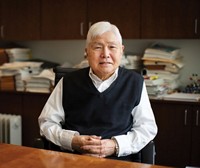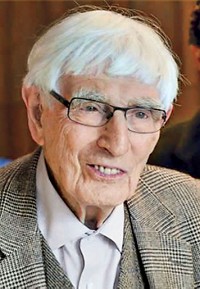Advertisement
Grab your lab coat. Let's get started
Welcome!
Welcome!
Create an account below to get 6 C&EN articles per month, receive newsletters and more - all free.
It seems this is your first time logging in online. Please enter the following information to continue.
As an ACS member you automatically get access to this site. All we need is few more details to create your reading experience.
Not you? Sign in with a different account.
Not you? Sign in with a different account.
ERROR 1
ERROR 1
ERROR 2
ERROR 2
ERROR 2
ERROR 2
ERROR 2
Password and Confirm password must match.
If you have an ACS member number, please enter it here so we can link this account to your membership. (optional)
ERROR 2
ACS values your privacy. By submitting your information, you are gaining access to C&EN and subscribing to our weekly newsletter. We use the information you provide to make your reading experience better, and we will never sell your data to third party members.
People
Carl Djerassi, Pioneer Of The Birth Control Pill, Dies At 91
Obituary: Chemist famous for synthesis of first oral contraceptive leaves behind scientific and artistic legacy
by Corinna Wu
February 2, 2015

Carl Djerassi, the organic chemist and writer best known for creating the hormone that formed the basis of the first oral contraceptive, passed away on Friday at age 91.
Although his most enduring fame came from developing a practical synthesis of the steroid norethindrone in 1951 with his coworkers at Syntex Corp., in Mexico City, Djerassi’s intellectual pursuits spanned the worlds of science and art. As a member of the scientific community, he was on the faculty at Wayne State University and later at Stanford University; he authored more than 1,200 scientific papers. In the last two decades of his life, Djerassi largely put aside research to explore scientific themes through literature, penning dozens of novels, plays, poems, and essays. He left behind another legacy when he created an artists’ residency program in the Santa Cruz Mountains, founded in honor of his late daughter, Pamela.
“Carl lived an extraordinary life and was truly a citizen of the world,” says Robert J. McMahon, professor and chair of the department of chemistry at the University of Wisconsin, Madison, where Djerassi received his Ph.D. in 1945. “Anyone who met Carl knew immediately that they were in the presence of a remarkable man. It was palpable.”
Born in Vienna in 1923, Djerassi arrived in the U.S. in 1939 as a refugee from Nazi Austria. After earning his bachelor’s degree in chemistry at Kenyon College, in Ohio, and then his doctorate at Wisconsin, Djerassi worked for four years on antihistamines and other drugs at a New Jersey subsidiary of the Swiss pharmaceutical company Ciba. He then accepted an offer to work at Syntex. In a memoir published last year, “In Retrospect: From the Pill to the Pen,” Djerassi recounts how he considered his time at Syntex as a bridge to an academic position. He insisted that any discovery he made be published in chemical journals.
During his time at Stanford, from 1959 to 2002, Djerassi made seminal contributions to the fields of mass spectrometry, magnetic circular dichroism, and optical rotary dispersion for elucidating the structure of complex molecules.
Djerassi received the National Medal of Science in 1973, the National Medal of Technology & Innovation in 1991, and the Priestley Medal—the American Chemical Society’s highest honor—in 1992.
Although he was often called “the Father of the Pill,” Djerassi looked at this nickname with a characteristic literary eye. He maintained that “in the parentage of every synthetic drug … the chemist—irrespective of gender—symbolizes the mother, with the chemical entity representing the egg.”





Join the conversation
Contact the reporter
Submit a Letter to the Editor for publication
Engage with us on Twitter